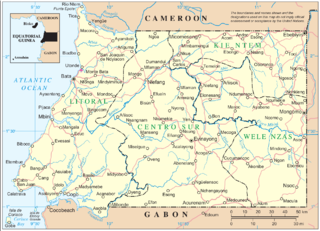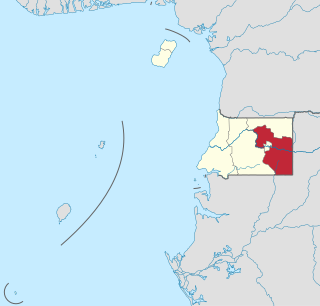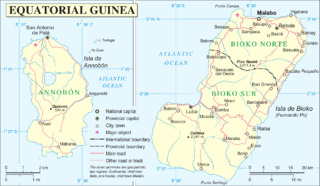
Equatorial Guinea, officially the Republic of Equatorial Guinea, is a country on the west coast of Central Africa, with an area of 28,000 square kilometres (11,000 sq mi). Formerly the colony of Spanish Guinea, its post-independence name refers to its location near both the Equator and in the African region of Guinea. As of 2021, the country had a population of 1,468,777, over 85% of whom are members of the Fang people, the country's dominant ethnic group. The Bubi people, indigenous to Bioko, are the second largest group at approximately 6.5% of the population.

The History of Equatorial Guinea is marked by centuries of colonial domination by the Portuguese, British and Spanish colonial empires, and by the local kingdoms.

The Republic of Equatorial Guinea is located in west central Africa. Bioko Island lies about 40 kilometers (24.9 mi) from Cameroon. Annobón Island lies about 595 kilometres (370 mi) southwest of Bioko Island. The larger continental region of Río Muni lies between Cameroon and Gabon on the mainland; it includes the islands of Corisco, Elobey Grande, Elobey Chico, and adjacent islets. The total land area is 28,051 km2 (10,831 sq mi). It has an Exclusive Economic Zone of 303,509 km2 (117,185 sq mi).

The politics of Equatorial Guinea take place in a framework of a presidential republic, whereby the President is both the head of state and head of government. Executive power is exercised by the government. Legislative power is vested in both the government and the Chamber of People's Representatives

This article lists transport in Equatorial Guinea.

Malabo is the capital of Equatorial Guinea and the province of Bioko Norte. It is located on the north coast of the island of Bioko. In 2018, the city had a population of approximately 297,000 inhabitants.

Río Muni is the Continental Region of Equatorial Guinea, and comprises the mainland geographical region, covering 26,017 square kilometres (10,045 sq mi). The name is derived from the Muni River, along which the early Europeans had built the Muni River Settlements.

Equatorial Guinea's culture has been less documented than most African countries, and commercial recordings remain scarce.

Equatorial Guinea is divided into two regions and eight provinces. The newest province is Djibloho, created in 2017 with its headquarters at Ciudad de la Paz, the country's future capital.

Annobón is a province of Equatorial Guinea. The province consists of the island of Annobón and its associated islets in the Gulf of Guinea. Annobón is the smallest province of Equatorial Guinea in both area and population. According to the 2015 census, Annobón had 5,314 inhabitants, a small population increase from the 5,008 registered by the 2001 census. The official language is Spanish but most of the inhabitants speak a creole form of Portuguese. The island's main industries are fishing and forestry.

Wele-Nzas Province is a province in the eastern portion of continental Equatorial Guinea. Its capital is Mongomo. It borders the Equatoguinean provinces of Centro Sur to the west and Kié-Ntem to the north, with Gabon's Woleu-Ntem Province to the east and south. As of 2015, the population of Wele-Nzas was 192,017. It derives its name from the Benito River and the Piedra Nzas mountain range.

Bata Airport is an airport serving Bata in Litoral, Equatorial Guinea. It is the second largest airport in Equatorial Guinea after Malabo International Airport.

Malabo Airport or Saint Isabel Airport, is an airport located at Punta Europa, Bioko Island, Equatorial Guinea. The airport is named after the capital, Malabo, approximately 9 kilometres (5.6 mi) to the east.

Articles related to Equatorial Guinea include:

SEGESA is the national electricity company of Equatorial Guinea, with its head offices in Malabo, Equatorial Guinea. It is the sole operator of the electricity sector of Equatorial Guinea. The company was created in November 2001 by a merger of the national rural electrification company SONER and the national electricity corporation ENERGE. In 2013 the company was reorganized into three units: SEGESA Comercial for distribution and sales, SEGESA Generación for generation activities and SEGESA Transmisión for transmission. The three units are overseen by SEGESA Holding.

The Insular Region of Equatorial Guinea comprises the former Spanish territory of Fernando Po, together with Annobón island, the latter formerly part of the Spanish territory of Elobey, Annobón, and Corisco, which was located in the Gulf of Guinea and in the Corisco Bay.
Djibloho – Ciudad de la Paz, formerly Oyala, is a city in Equatorial Guinea that is being built to replace Malabo as the national capital. Established as an urban district in Wele-Nzas in 2015, it is now the administrative headquarters of Djibloho, Equatorial Guinea's newest province created in 2017, and is located near the town of Mengomeyén. In 2017, the city was officially renamed Ciudad de la Paz.
Equatorial Guinea is a unitary republic located on the west coast of Africa which is divided into eight provinces, 19 districts and 32 municipalities. These are organized as shown in the following table. Municipalities that are the capitals of their respective provinces are shown in bold.

Equatorial Guinea–Spain relations are the diplomatic relations between Equatorial Guinea and Spain. Both nations are members of the Association of Academies of the Spanish Language, Organization of Ibero-American States and the United Nations.

Equatorial Guinea–Venezuela relations refers to international relations between Equatorial Guinea and Venezuela. In both countries the official language is Spanish and they have an important economic activity based on oil extraction.















